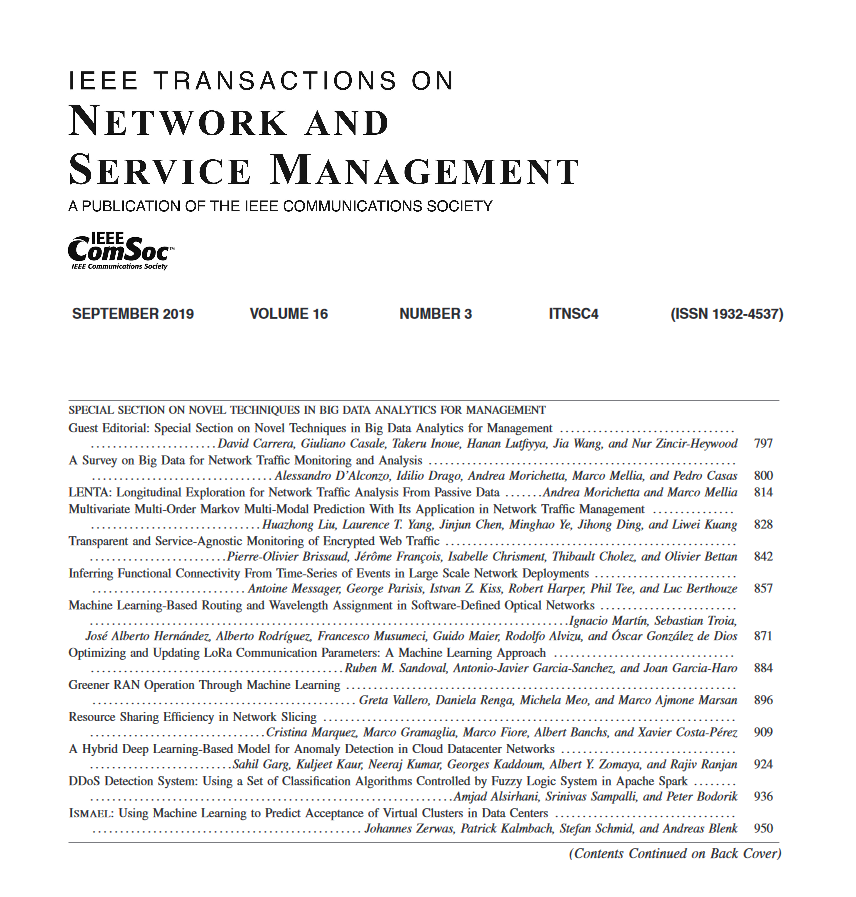DRL-Based Maximization of the Sum Cross-Layer Achievable Rate for Networks Under Jamming
IF 5.4
2区 计算机科学
Q1 COMPUTER SCIENCE, INFORMATION SYSTEMS
IEEE Transactions on Network and Service Management
Pub Date : 2025-01-24
DOI:10.1109/TNSM.2025.3534028
引用次数: 0
Abstract
In quasi-static wireless networks characterized by infrequent changes in the transmission schedules of user equipment (UE), malicious jammers can easily deteriorate network performance. Accordingly, a key challenge in these networks is managing channel access amidst jammers and under dynamic channel conditions. In this context, we propose a robust learning-based mechanism for channel access in multi-cell quasi-static networks under jamming. The network comprises multiple legitimate UEs, including predefined UEs (pUEs) with stochastic predefined schedules and an intelligent UE (iUE) with an undefined transmission schedule, all transmitting over a shared, time-varying uplink channel. Jammers transmit unwanted packets to disturb the pUEs’ and the iUE’s communication. The iUE’s learning process is based on the deep reinforcement learning (DRL) framework, utilizing a residual network (ResNet)-based deep Q-Network (DQN). To coexist in the network and maximize the network’s sum cross-layer achievable rate (SCLAR), the iUE must learn the unknown network dynamics while concurrently adapting to dynamic channel conditions. Our simulation results reveal that, with properly defined state space, action space, and rewards in DRL, the iUE can effectively coexist in the network, maximizing channel utilization and the network’s SCLAR by judiciously selecting transmission time slots and thus avoiding collisions and jamming.干扰下基于drl的网络跨层可达速率总和最大化
在准静态无线网络中,用户设备(UE)的传输时间表变化不频繁,恶意干扰器很容易降低网络性能。因此,这些网络面临的一个关键挑战是如何在干扰器和动态信道条件下管理信道接入。在这种情况下,我们提出了一种基于学习的稳健机制,用于多小区准静态网络中的干扰情况下的信道接入。网络由多个合法 UE 组成,包括具有随机预定时间表的预定义 UE(pUE)和具有未定义传输时间表的智能 UE(iUE),所有 UE 都通过共享的时变上行链路信道进行传输。干扰器发射不需要的数据包,干扰 pUE 和 iUE 的通信。iUE 的学习过程基于深度强化学习(DRL)框架,利用基于残差网络(ResNet)的深度 Q 网络(DQN)。为了在网络中共存并最大限度地提高网络的跨层总可实现率(SCLAR),iUE 必须在学习未知网络动态的同时适应动态信道条件。我们的仿真结果表明,在 DRL 中正确定义了状态空间、行动空间和奖励后,iUE 可以有效地在网络中共存,通过明智地选择传输时隙最大化信道利用率和网络的 SCLAR,从而避免碰撞和干扰。
本文章由计算机程序翻译,如有差异,请以英文原文为准。
求助全文
约1分钟内获得全文
求助全文
来源期刊

IEEE Transactions on Network and Service Management
Computer Science-Computer Networks and Communications
CiteScore
9.30
自引率
15.10%
发文量
325
期刊介绍:
IEEE Transactions on Network and Service Management will publish (online only) peerreviewed archival quality papers that advance the state-of-the-art and practical applications of network and service management. Theoretical research contributions (presenting new concepts and techniques) and applied contributions (reporting on experiences and experiments with actual systems) will be encouraged. These transactions will focus on the key technical issues related to: Management Models, Architectures and Frameworks; Service Provisioning, Reliability and Quality Assurance; Management Functions; Enabling Technologies; Information and Communication Models; Policies; Applications and Case Studies; Emerging Technologies and Standards.
 求助内容:
求助内容: 应助结果提醒方式:
应助结果提醒方式:


